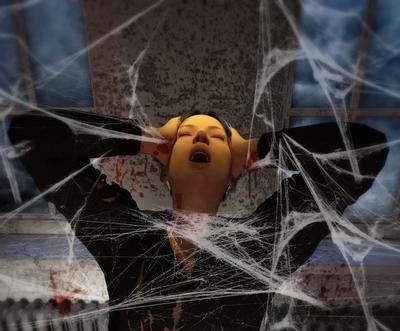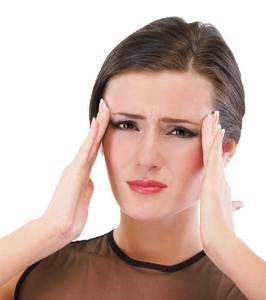|
 Bumping into a needle or touching a hot surface, a person immediately withdraws his hand. Tooth pain prompts you to see a doctor. These examples illustrate physiological pain, which the ancient Greeks called "the watchdog of health." Bumping into a needle or touching a hot surface, a person immediately withdraws his hand. Tooth pain prompts you to see a doctor. These examples illustrate physiological pain, which the ancient Greeks called "the watchdog of health."
It would seem that the same situation occurs with trigeminal neuralgia. The feeling is that several teeth hurt, the jaw breaks, the person is unable to work or sleep. But you can pull out your teeth, you can even cut a nerve, and the pain does not always disappear.
Or: a person suffers from phantom (ghostly) pain when his finger is amputated, but it hurts! Often, pain occurs due to the fact that the scar tissue compresses the nerve fibers in the stump or inflammation develops in it. But how to explain phantom pain when there are no pathological changes in the cult? Obviously, in this case, as in the case of trigeminal neuralgia, pain is formed in the central nervous system itself, in the depths of the brain. Until now, it was not always possible to get rid of such chronic pathological pain with therapeutic agents.
For centuries, mankind has been looking for effective ways to suppress pain in general and chronic pain in particular. According to statistics, hundreds of thousands of people around the world suffer from the latter. Solving the problem required the consolidation of the efforts of scientists. The urgency of the problem is evidenced by the organization of the International Association for the Study of Pain, two congresses held by it, the publication of a special scientific journal "Payne" ("Pain"),
 In recent years, a lot of data have been obtained that made it possible to answer a number of important, one might say, fundamental questions. First of all, the existence of a specialized system of pain sensations, formed in the process of evolution, was finally established in the body of animals and humans. In recent years, a lot of data have been obtained that made it possible to answer a number of important, one might say, fundamental questions. First of all, the existence of a specialized system of pain sensations, formed in the process of evolution, was finally established in the body of animals and humans.
Receptor devices located everywhere (in the skin, mucous membranes, etc.) (the so-called free nerve endings) perceive painful irritation arising from the action of damaging agents, and transmit it along the conductive nerve pathways to the brain, where this irritation is perceived as a sensation of pain ... The entire hierarchy — from receptors to the cerebral cortex — constitutes the pain sensitivity system, or, as they say now, the nociceptive system.
In addition to receptor apparatus, there are three levels, three levels of the nociceptive system. Each is formed from a group (nucleus) of neurons, at each level information encoded in the form of nerve impulses is received, processed and sent further.
Pain signals are transmitted by excitatory neurons connected by feedbacks. Thanks to such communications, neurons are able to mutually activate each other, amplifying the incoming impulses. In the vicinity of the excitatory, in the same nuclei, inhibitory neurons are located, whose task is to muffle, weaken the flow of impulses.
Functions of these opposite nerve cells are surprisingly coordinated. If the flow of impulses from the periphery faded as it moved from floor to floor, then the brain would be in the dark about the danger threatening the body. But if each signal, gradually increasing, reached the brain like a cry of pain, then any scratch would be perceived as a harbinger of an impending catastrophe, and we would constantly be in an agitated or depressed state. But the organs cope with some injuries on their own, without the participation of the higher parts of the central nervous system.
This is why inhibitory neurons are so important. Thanks to their constant interaction with antagonists, the brain of a healthy person always receives information appropriate to a specific situation.If excitation from the periphery is excessive and inadequate to stimulation, inhibitory neurons will suppress it already at the entrance to the spinal cord or in the next nucleus. At the same time, a signal about a real danger (and this is largely determined by the nature of the flow of impulses) will pass quickly, unimpeded, and can even be amplified. This is how the apparatus for regulating impulse flows in the pain sensitivity system function.
However, if everything is so clearly coordinated, then how, where, at what point does chronic pathological pain occur? And why is it so difficult to fight it?
Apparently, this happens when the brake-regulating mechanisms fail. At the same time, neurons, usually only receiving, amplifying and transmitting signals about pain, can themselves begin to generate streams of impulses. In this situation, the periphery only needs to start the mechanism (and by any insignificant irritation), how it will start working further on its own, and even with increased energy.
So a group of neurons becomes a generator of increased excitation in the nociceptive system. This generator works in different modes. The entire group of cells can "explode" instantly, creating a sensation of an attack of acute pain, which happens, in particular, with the already mentioned trigeminal neuralgia. The aching pain is characterized by a long, tonic mode of operation of the generator.
 The reasons for the formation of generators of chronic pathological pain (or otherwise central pain syndromes) can be different: for example, metabolic disorders in nerve cells or their blood supply. The mechanism of formation of any such generator, as our studies have shown, is always the same: adverse effects on the central nervous system first of all knock out, as the weakest, the inhibitory apparatus of the nociceptive system, and excitatory neurons get rid of the restraining bridle. The validity of our hypothesis was confirmed by experimental models of pain syndromes. The reasons for the formation of generators of chronic pathological pain (or otherwise central pain syndromes) can be different: for example, metabolic disorders in nerve cells or their blood supply. The mechanism of formation of any such generator, as our studies have shown, is always the same: adverse effects on the central nervous system first of all knock out, as the weakest, the inhibitory apparatus of the nociceptive system, and excitatory neurons get rid of the restraining bridle. The validity of our hypothesis was confirmed by experimental models of pain syndromes.
The concept of the mechanism of generation of generators of increased excitation is confirmed by clinical data. For example, it has long been known that anticonvulsants suppress some pain syndromes. Now it became clear why this is happening. These drugs, while reducing the overstimulation underlying, for example, an epileptic seizure, at the same time inhibit the action of pain generators.
By the way, the constant activity of the inhibitory apparatus of the nociceptive system is usually supported by streams of impulses going through independent channels, including from peripheral pain receptors. If the flow of impulses becomes scarce and even less stops completely, then the inhibitory cells become silent, and this is where the flow of excitation grows.
Therefore, one of the ways to combat chronic pathological pain can be irritation in a certain mode of nerve formations at the first level of the nociceptive system, for example, irritation of the posterior columns of the spinal cord. A similar effect can be obtained in another way: by stimulating the structures of the spinal cord associated with the inhibitory apparatus. In this case, the excitation generator in the nociceptive system will be suppressed. Such techniques can also relieve constant pain. Now this therapeutic effect, which doctors sometimes achieve with intensive physiotherapy, is being explained in the same way as the analgesic effect of antiepileptic drugs.
Another way to overcome pathological pain is associated with the study of the chemical nature of the generators of excessive excitation and the structures that inhibit their activity. Experimental models have shown that the most effective drugs in the fight against pain can be those drugs that specifically activate inhibitory elements. As it became known in recent years, various ensembles of such neurons located in the same nucleus perform their functions using various mediators.This, by the way, explains the well-known fact that with an outwardly identical clinical picture of the disease, this or that drug helps not all patients - only those who have inhibitory structures and bonds in the nuclei of the nociceptive system that have an affinity for the introduced chemical compound.
Finally, a third, new and very promising way of dealing with pathological pain is outlined. So far, we've talked about the nociceptive system. But in our body, the antinociceptive system also operates, which was discovered literally in the very last years. It is in her jurisdiction that the aforementioned inhibitory devices, which are located in the nuclei of the pain sensitivity system, are located. These structures are activated by impulses from various parts of the brain, which, in turn, receive signals from the nuclei of the nociceptive system. The stronger the excitation of the latter, the more the structures of the antinociceptive system are activated and the more effective its analgesic effect. This assumption has been convincingly proven in research laboratories in our country and abroad. By irritating the above structures through precisely inserted electrodes, the scientists achieved a complete loss of pain sensitivity in the experimental animal.
 Studying these phenomena, we drew attention to an extremely interesting phenomenon: the analgesic effect persisted even after the termination of electrical stimulation. This means that something reinforces this effect. Isn't there also a generator that maintains the state of insensitivity working here? To answer this question, we introduced stimulating substances into the nuclei of the antinociceptive system, creating in it the same excitation generators as in the nociceptive system. And the effect was amazing - the experimental animal did not feel pain even when causing pain syndromes. Studying these phenomena, we drew attention to an extremely interesting phenomenon: the analgesic effect persisted even after the termination of electrical stimulation. This means that something reinforces this effect. Isn't there also a generator that maintains the state of insensitivity working here? To answer this question, we introduced stimulating substances into the nuclei of the antinociceptive system, creating in it the same excitation generators as in the nociceptive system. And the effect was amazing - the experimental animal did not feel pain even when causing pain syndromes.
Thus, if earlier physiologists had the right to talk about the central mechanisms of pain syndromes, now they have the same right to talk about the central generator mechanisms of anesthesia. More and more data is emerging indicating that many substances that cause general analgesia do not generally act on the brain. and it is the structures of the antinociceptive system that excite. In other words, they do not suppress pain by themselves, but activate the anti-pain system. For example, introducing radioactive morphine into the body of an animal, scientists then discovered it in areas of the brain that are links of the anti-pain system. Based on the results obtained, one can think that the antinociceptive system exercises, as it were, the supreme control over maintaining the balance between excitation and inhibition in the nociceptive system, turning on whenever the inhibitory devices of the latter lose the ability to resist excessive excitation.
But since morphine is concentrated in these structures, it means that there are some receptors with which morphine binds. Otherwise, he would not have been able to exert his effect.
The question immediately arises: how to explain the existence of these receptors? After all, morphine is a chemical compound foreign to the body.
Scientists have come to a logical conclusion: in the body in response to painful irritation, some morphine-like substances are released that have an analgesic effect. Such substances (they were called endorphins and enkephalins) were soon actually discovered and isolated. The former, as it turned out, entering the bloodstream, can retain their amazing strength for a long time, many times greater than that of morphine. The latter act in the brain itself and are quickly destroyed. With enkephalins and endorphins, with their derivatives and synthetic analogs, many scientists now associate the most optimistic hopes in the fight against chronic pathological pain.
G. N. Kryzhanovsky
|
 Bumping into a needle or touching a hot surface, a person immediately withdraws his hand. Tooth pain prompts you to see a doctor. These examples illustrate physiological pain, which the ancient Greeks called "the watchdog of health."
Bumping into a needle or touching a hot surface, a person immediately withdraws his hand. Tooth pain prompts you to see a doctor. These examples illustrate physiological pain, which the ancient Greeks called "the watchdog of health." In recent years, a lot of data have been obtained that made it possible to answer a number of important, one might say, fundamental questions. First of all, the existence of a specialized system of pain sensations, formed in the process of evolution, was finally established in the body of animals and humans.
In recent years, a lot of data have been obtained that made it possible to answer a number of important, one might say, fundamental questions. First of all, the existence of a specialized system of pain sensations, formed in the process of evolution, was finally established in the body of animals and humans. The reasons for the formation of generators of chronic pathological pain (or otherwise central pain syndromes) can be different: for example, metabolic disorders in nerve cells or their blood supply. The mechanism of formation of any such generator, as our studies have shown, is always the same: adverse effects on the central nervous system first of all knock out, as the weakest, the inhibitory apparatus of the nociceptive system, and excitatory neurons get rid of the restraining bridle. The validity of our hypothesis was confirmed by experimental models of pain syndromes.
The reasons for the formation of generators of chronic pathological pain (or otherwise central pain syndromes) can be different: for example, metabolic disorders in nerve cells or their blood supply. The mechanism of formation of any such generator, as our studies have shown, is always the same: adverse effects on the central nervous system first of all knock out, as the weakest, the inhibitory apparatus of the nociceptive system, and excitatory neurons get rid of the restraining bridle. The validity of our hypothesis was confirmed by experimental models of pain syndromes. Studying these phenomena, we drew attention to an extremely interesting phenomenon: the analgesic effect persisted even after the termination of electrical stimulation. This means that something reinforces this effect. Isn't there also a generator that maintains the state of insensitivity working here? To answer this question, we introduced stimulating substances into the nuclei of the antinociceptive system, creating in it the same excitation generators as in the nociceptive system. And the effect was amazing - the experimental animal did not feel pain even when causing pain syndromes.
Studying these phenomena, we drew attention to an extremely interesting phenomenon: the analgesic effect persisted even after the termination of electrical stimulation. This means that something reinforces this effect. Isn't there also a generator that maintains the state of insensitivity working here? To answer this question, we introduced stimulating substances into the nuclei of the antinociceptive system, creating in it the same excitation generators as in the nociceptive system. And the effect was amazing - the experimental animal did not feel pain even when causing pain syndromes.









